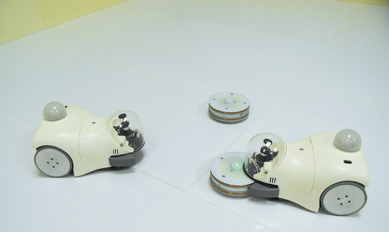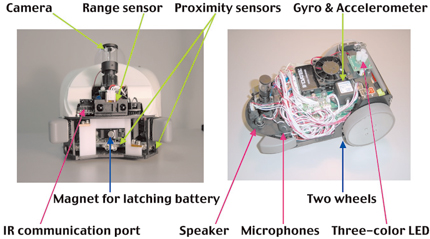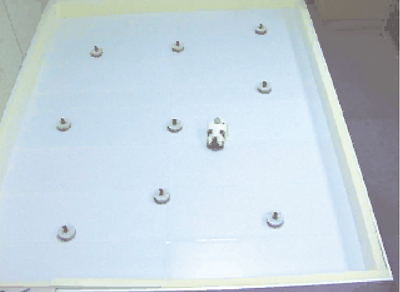Cyber Rodents are a robotic platform for studying the necessary functions of adaptive agents under the constraints of self-preservation and self-reproduction, which are the defining features of life. We are exploring the mechanisms of learning and evolution by using these rodent-like robots, which are capable of capturing battery packs and exchanging "genes" through infrared communication.
1. Can a robot have emotions?
The creation of robots that are able to recognize human emotions and express their own emotions is a major dream for robotic researchers. To realize that goal, studies on the visual recognition of facial expressions and the mechanical implementation of expressive faces using subtle eyebrow and mouth movements are under way. Will it be possible, then, to make a humanoid robot that actually posses human-like emotions by precisely replicating human rules of recognition and expression of emotions?
When we talk about emotion, we first think about rich expressions like smiling and crying, and vivid subjective feelings like joy and pain. But what are our emotions really for? Are they just a privilege given to humankind to make life more complex and dramatic?
Let us consider emotion as a biological mechanism that supports two of the basic principles of life: self-preservation and self-reproduction. Strong emotional feelings, like hunger, thirst, and pain promote the survival of individuals, while others, like sexual drive, love, and sorrow aid in reproduction and protection of the genetic community. Human life is full of more complex emotions and desires, like the quest for fame and money, and excitement with curiosity and ambition, but they can somehow be traced back to basic emotions for self-survival and self-reproduction.
2. Cyber Rodents
In trying to understand the mechanisms required for adaptive creatures that have the same constraints as biological creatures, we started out to build Cyber Rodents (Figure 1). Cyber Rodents are meant to resemble rats or mice, about which there are a wealth of neuroethological studies, but they are rather large, at 22 cm in body length. Cyber Rodents forage for battery packs and recharge from them for self-survival. Although it is difficult to achieve reproduction in hardware, Cyber Rodents can copy their 'genes' through infrared (IR) communication to reproduce in software. Each Cyber Rodent is endowed with a variety of sensory inputs, including a wide-angle C-MOS camera, an IR range sensor, seven IR proximity sensors, gyros, and accelerometers (Figure 2). Its motion system consists of two wheels and a magnetic jaw that latches onto battery packs. A Cyber Rodent's 'brain' consists of a SuperH-4 CPU chip and an FPGA chip for real-time visual processing, which allow fully on-board, real-time learning and control. It also has a speaker, two microphones, a three-color LED, and an IR communication port for audio-visual communication and the hardware implementation of evolutionary algorithms. It is further equipped with USB and wireless communication ports for connection with a host computer, so that hardware experiments and software simulations can be seamlessly integrated.





